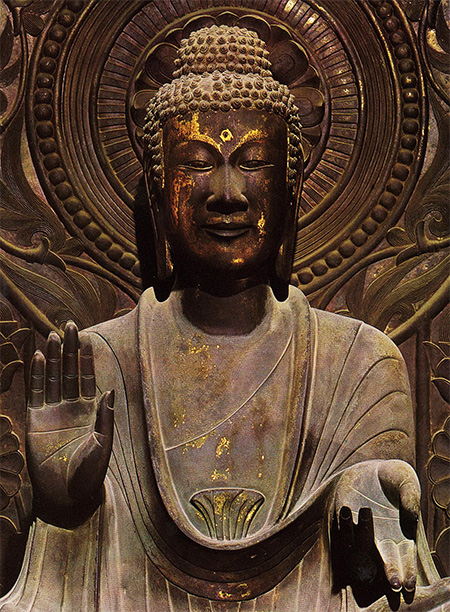

さてここのところ、飛鳥寺を巡っての記事連載。
いろいろと掘り下げて時代相などを見てきたのですが、
やはり飛鳥大仏さんの独特の表情に深く魅了されていたことがわかった。
止利仏師さんの作品世界に耽溺していたのですね。
上の写真は法隆寺金堂・釈迦三尊像のうち真ん中の釈迦如来像。
そして下の写真は飛鳥大仏であります。
やや面長で独特の柔和な微笑が特徴でしょうか。
「人形は顔がいのち」というのは人形の久月のCM定型句ですが、
(あれ、これはもしかして昔住んでいた首都圏ローカルネタかなぁ?)
どうもわたしも仏像は顔がいのちなのではないかと思い始めています。
自分ではまだまだ若いつもりではあるのですが、
こういった仏像の表情に格別の思い入れが生まれてくるのは
どうもヤバいような気もします(笑)。
まぁしかし、実際に仏像を見つめていると作者と心的対話が可能。
添え書きとしての歴史事実、時代背景を空間軸知識として援用して
こういった仏像を見続けることは、趣味としてかなり永続性がある。
噛めば噛むほどに味わいが深まっていくような
そういう底なし沼的な怖ろしさも感じられる。
けれど、その魅力の虜になってしまう忘我のよろこびを強く感じる。
仏像にピンナップされる「表情」からは実に多彩な心象がみえる。
この釈迦如来像は造仏の機縁として聖徳太子の病気平癒の願掛けがあって、
もしそれが叶わぬのであれば、安寧な死、死後の魂の平安を祈念したとされる。
止利仏師さんにとっても、自らの造仏活動をバックアップしてくれた
聖徳太子さんへの感謝の気持ちもきっとあったのではと推測すれば
この表情の独特の穏やかさにはつたわってくるモノがある。
相対的にはより若い時期の飛鳥大仏の表情と比べて
こちらの方には加齢してのこころの平安が感じられるような気がする。
こういう造形の周辺的な感情の部分までがきっと表現されるのではないか。
考えて見ればこうした創造営為は時代を映し出すメディアの役割があったかも。
その時代が必要とされる創造行為にあたって
作者を選択し、その制作意図を伝え命令し、表現させた。
そこでの制作表現にはかなりたくさんの「思い」が込められたことでしょう。
未来の人々に向けた時代からのメッセージもそこにはある。
歴史時間の表現というメディア性があるのでしょう。
わたしがなんとなく飛鳥時代の日本について惹かれるものがあるのは、
こうした鞍作止利さんの時代表現に導かれているのでしょうね。
English version⬇
[Attracted by the Buddha statue of Tori Busshi, Japan’s first temple, Asuka-dera-8]
By the way, recently, a series of articles about Asuka-dera.
I have delved into various things and looked at the times, etc.
It turned out that I was deeply fascinated by the unique expression of Asuka Daibutsu.
You were indulged in the world of Tori Busshi’s work.
The photo above is the statue of Shaka Nyorai in the middle of the statues of Shakyamuni and Three Sons of Horyuji Temple.
And the photo below is Asuka Daibutsu.
Is it characterized by a slightly long face and a unique gentle smile?
“A doll has a face” is a CM phrase for Kyugetsu, a doll.
(Oh, maybe this is a local story in the metropolitan area where I used to live?)
I’m starting to think that Buddha statues have a life on their faces.
I think I’m still young,
The expression of these Buddha statues gives rise to a special feeling.
I feel like it’s dangerous (laughs).
However, if you are actually staring at the Buddha statue, you can have a mental dialogue with the author.
Incorporating historical facts and historical background events as annexes as spatial axis knowledge
Keeping an eye on these Buddha statues is a hobby that is quite permanent.
The more you chew, the deeper the taste
You can feel the scaryness of such a bottomless swamp.
However, I strongly feel the joy of forgetting to be captivated by its charm.
From the “facial expressions” pinned up by the Buddha statue, you can see a wide variety of mental images.
This statue of Shaka Nyorai has a wish to heal Prince Shotoku’s illness as a mechanism for making Buddha.
If that doesn’t happen, it is said that he prayed for a peaceful death and peace of the soul after death.
Tori Busshi also backed up his own Buddhist activities.
If you guess that there was a feeling of gratitude to Prince Shotoku
The unique calmness of this expression has something to do with it.
Compared to the expression of the Asuka Daibutsu when he was relatively younger
I feel that this person can feel the peace of mind as they age.
I’m sure that even the peripheral emotional part of this kind of modeling will be expressed.
If you think about it, this kind of creative activity may have played the role of a medium that reflects the times.
In the creative act that the era is needed
The author was selected, and the intention of the production was conveyed, ordered, and expressed.
Even there, there must have been quite a lot of “thoughts” in the production expression.
There is also a message from that era to the people of the future.
Perhaps there is a media nature of expressing such historical time.
What I am attracted to about Japan in the Asuka period is
Perhaps it is guided by Tori Busshi’s era expression.
Posted on 10月 21st, 2021 by 三木 奎吾
Filed under: 住宅マーケティング, 日本社会・文化研究







コメントを投稿
「※誹謗中傷や、悪意のある書き込み、営利目的などのコメントを防ぐために、投稿された全てのコメントは一時的に保留されますのでご了承ください。」
You must be logged in to post a comment.